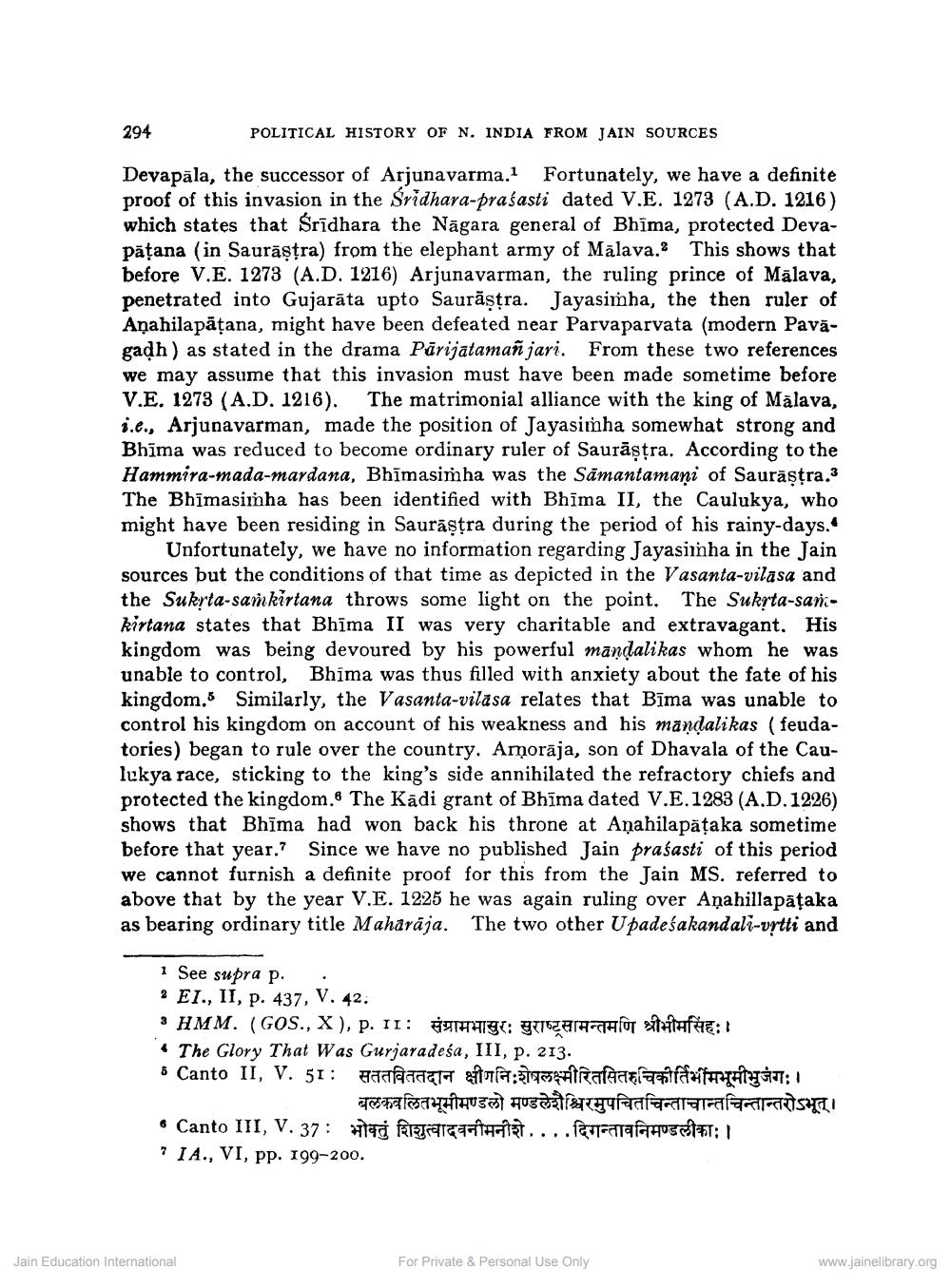________________
294
POLITICAL HISTORY OF N. INDIA FROM JAIN SOURCES
Devapāla, the successor of Arjunavarma. Fortunately, we have a definite proof of this invasion in the Sridhara-prasasti dated V.E. 1273 (A.D. 1216) which states that Srīdhara the Nāgara general of Bhīma, protected Devapāšana (in Saurāşțra) from the elephant army of Mālava. This shows that before V.E. 1273 (A.D. 1216) Arjunavarman, the ruling prince of Mālava, penetrated into Gujarāta upto Saurāştra. Jayasimha, the then ruler of Anahilapāțana, might have been defeated near Parvaparvata (modern Pavāgadh) as stated in the drama Pārijataman jari. From these two references we may assume that this invasion must have been made sometime before V.E. 1273 (A.D. 1216). The matrimonial alliance with the king of Mälava, j.e., Arjunavarman, made the position of Jayasimha somewhat strong and Bhīma was reduced to become ordinary ruler of Saurāsțra. According to the Hammira-mada-mardana, Bhīmasimha was the Samantamani of Saurastra.3 The Bhīmasimha has been identified with Bhīma II, the Caulukya, who might have been residing in Saurastra during the period of his rainy days.
Unfortunately, we have no information regarding Jayasinha in the Jain sources but the conditions of that time as depicted in the Vasanta-vilasa and the Sukrta-samkirtana throws some light on the point. The Sukrta-sankirtana states that Bhīma II was very charitable and extravagant. His kingdom was being devoured by his powerful mandalikas whom he was unable to control, Bhima was thus filled with anxiety about the fate of his kingdom. Similarly, the Vasanta-vilasa relates that Bīma was unable to control his kingdom on account of his weakness and his mandalikas ( feudatories) began to rule over the country. Armorāja, son of Dhavala of the Caulukya race, sticking to the king's side annihilated the refractory chiefs and protected the kingdom. The Kādi grant of Bhīma dated V.E.1283 (A.D. 1226) shows that Bhīma had won back his throne at Anahilapätaka sometime before that year.? Since we have no published Jain praśasti of this period we cannot furnish a definite proof for this from the Jain MS. referred to above that by the year V.E. 1225 he was again ruling over Anahillapāțaka as bearing ordinary title Maharāja. The two other Upadeśakandali-vrtti and
1 See supra p. . 3 EI., II, p. 437, V. 42. : HMM. (GOS., X), p. II: THET: GIZARA HOT that: · The Glory That Was Gurjaradeśa, III, p. 213. 6 Canto II, V. 51: Face Tata Tatatrafegaranty 2:1
बलकवलितभूमीमण्डलो मण्डलेशैश्चिरमुपचितचिन्ताचान्तचिन्तान्तरोऽभूत्। . Canto III, V. 37: 90 Talcaha.... atafsetT: 1
I A., VI, pp. 199–200.
Jain Education International
For Private & Personal Use Only
www.jainelibrary.org




